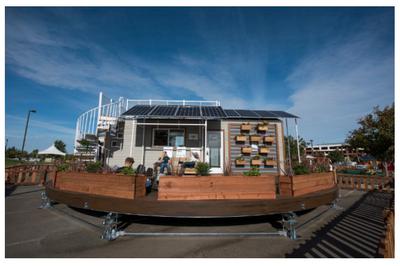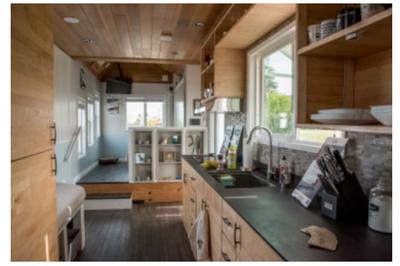Voices: 7 things I learned from building a tiny house
by Anna Harris
(http://college.usatoday.com)

I was part of Santa Clara University’s rEvolve House team where a group of undergraduate students designed and built an off-grid tiny house (on wheels!) for a nonprofit called Operation Freedom Paws (OFP), which empowers veterans to take back their independence.
I still can’t believe we built a home from the ground up. And despite all of the long, hard hours of planning and physical labor, I wouldn’t give up that time for anything.
Involvement in the project was open to all students, but the majority of the team ended up being engineers. As a civil engineering junior, I got involved because I liked the end purpose of the house and was interested in a way to apply what I had learned in my classes to a real project. I ended up learning a lot more than I bargained for.
Here are some of my takeaways from building a tiny house:
The interior of Santa Clara University's rEvolve House. (Photo: Joanne H. Lee, Santa Clara University)
The interior of Santa Clara University’s rEvolve House. (Photo: Joanne H. Lee, Santa Clara University)
FIND GREAT MENTORS AND DON’T BE AFRAID TO ASK FOR THEIR HELP
Building a tiny house is hard work. There’s no getting around that. You will encounter problems you don’t know how to solve. When this happens, try to figure it out. Do research. But if you still have no solution, don’t be afraid to ask for help.
We wouldn’t have a completed house right now if it weren’t for all of our incredible mentors, including faculty and local contractors in the area. If I were to list everyone that helped us out, this article would never end.
VIEW MISTAKES AS LEARNING EXPERIENCES
Even with the best mentors, mistakes and roadblocks are bound to happen. Learn from them. Everyone on the team made mistakes and I was no exception. One of my mistakes cost us $250.
We have 10 windows (and one skylight) in our house – a lot compared to most tiny houses. One of my jobs was to determine the exact placement and size of every one of those windows and then convey those measurements to the window manufacturer and the company that made our pre-manufactured structural insulated panel walls. After feeling confident that all of the measurements were correct, I ordered both the walls and the windows. When it came time to place the windows, our largest window was off by a foot.
I was frustrated that I’d made this mistake but was lucky to have a team around me who helped me replace the window instead of getting upset at my mistake. In the end, this blunder reminded me to think of the saying “measure twice, cut once” from then on, which ended up helping me catch future mistakes.
NO IDEA IS EVER TOO CRAZY
Portrait of the Tiny House team members inside their rEvolve House during the 2016 Tiny House Competition in Sacramento on October 13, 2016. When the contest is over, the 238-square-foot solar-powered home will go to Operation Freedom Paws (OFP), a 501(c)3 nonprofit organization empowering military veterans and others with disabilities to restore their independence by teaming them up with a service dog. (Photo: Joanne H. Lee, Santa Clara University)
Portrait of the Tiny House team members inside their rEvolve House during the 2016 Tiny House Competition in Sacramento on October 13, 2016. When the contest is over, the 238-square-foot solar-powered home will go to Operation Freedom Paws (OFP), a 501(c)3 nonprofit organization empowering military veterans and others with disabilities to restore their independence by teaming them up with a service dog. (Photo: Joanne H. Lee, Santa Clara University)
When Colossun, a company based in Spain, approached us with the idea of having our entire house rotate to track the sun and increase our solar panel’s efficiency by about 30 percent, we thought it was crazy. But the more we thought about it, the more we liked the idea. It would decrease the number of solar panels we needed and would certainly set our house apart from the other tiny houses. I don’t think we would have won Sacramento Municipal Utility District’s first-ever tiny house competition without it.
The rotating aspect of our house was a good idea not only because it helped set us apart at the competition, but also because the craziest ideas are often the ones you learn the most from.
Related: Santa Clara University students join the tiny house movement
FIND THE POSITIVE IN EVERY NEGATIVE
In April 2016, our mentor and faculty adviser, Father Reites, passed away. It was an enormous blow to our team. As much as we loved to complain about how much work he put on each of our plates, he was the one that pushed us to do better than we thought possible. Without him, we would have been much farther behind on the project. He motivated us to take risks and do more. Nothing was too much work in his view.
His passing was tough because we lost a mentor, a motivator, and a friend, but we used it as encouragement to re-dedicate ourselves to the project and work hard to bring back a win in his honor.
WORKING LATE ISN’T ALWAYS A BAD THING
This summer, we were planning on working 40 hours a week on the house’s construction but it ended up being a lot more. We started by working two extra hours a day but that increased until we left for the competition. By then we were working from 9 a.m. until midnight or 1 a.m., a few times even past 4 a.m., and then would go work on our homework. We only left the site to eat and go to
class. On the weekends we would get a break and only work from 9 a.m. to 9 p.m.
I think everyone on the team had at least one moment when they got overwhelmed or wanted to give up, but the rest of the team was always there to help motivate and pick up the slack. It was all of these late nights that allowed us to get the project done on time and bond as a team.
Images of the interior of Santa Clara University's rEvolve House during the 2016 Tiny House Competition in Sacramento on October 13, 2016. When the contest is over, the 238-square-foot solar-powered home will go to Operation Freedom Paws (OFP), a 501(c)3 nonprofit organization empowering military veterans and others with disabilities to restore their independence by teaming them up with a service dog. Sacramento Municipal Utility District (SMUD) is hosting a Tiny House Competit-zero energy houses. (Photo credit: Joanne H. Lee/Santa Clara University)
(Photo: Joanne H. Lee, Santa Clara University)
WOMEN CAN BE ENGINEERS AND CONSTRUCTION WORKERS, TOO
Now this one I didn’t learn from building our tiny house – I had known it as long as I had known what engineering was. But having come from an all-girls middle and high school, I had never before worked so closely with a bunch of guys.
Like most of engineering, the team was predominately male. Of the 15 of us who went to the competition, there were 12 guys and three women. The gender disparity didn’t surprise me. In fact, I hardly noticed it at first. However, as I became more involved I noticed it more. I was the only female engineering lead and started finding myself in meetings where I was the only woman. It felt strange at first but all of the guys were incredibly welcoming and before long they were calling me “one of the guys.”
THE TEAM MAKES THE DIFFERENCE
I don’t think I would have been able to do it without the support of the team. When you spend that much time with your team you get to know them very well. … Maybe too well. We lucked out that we were a very cohesive group. We chose to spend time with each other outside of our tiny house work.
We started out as just a team, but now we are a family and I know we will remain that way. We have all already invited each other to our future weddings.
Anna Harris is a senior at Santa Clara University majoring in civil engineering. She was the lead civil engineer on the rEvolve House team.
Join in and write your own page! It's easy to do. How? Simply click here to return to News portal.





